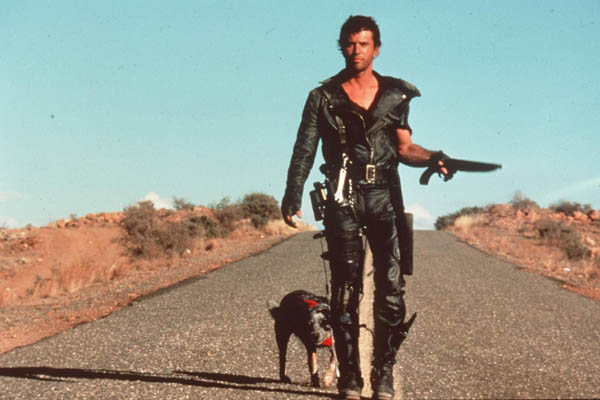 THE ROAD WARRIOR (1981); Dir: George Miller; Starring Mel Gibson, Bruce Spence, Kjell Nilsson; Wed. Nov. 21 9:30 p.m.; Plaza Theatre; Presented by Astrodog; trailer here.
THE ROAD WARRIOR (1981); Dir: George Miller; Starring Mel Gibson, Bruce Spence, Kjell Nilsson; Wed. Nov. 21 9:30 p.m.; Plaza Theatre; Presented by Astrodog; trailer here.
By Andrew Kemp
Contributing Writer
George Miller’s THE ROAD WARRIOR is the STAR WARS of the post-apocalypse. The film didn’t invent the genre, but it seemed to perfect it and codify it for an entire generation of fans while simultaneously transforming Mel Gibson into a household name, and it’s returning to the big screen for one night only at the Plaza Theatre on November 21 at 9:30 p.m., presented by Astrodog.
One man alone in a wasteland. A growling convoy of modified trucks driven by thieves and thugs. A shantytown built from spare parts and spare people. We’ve seen these elements before, clichés of the post-apocalypse. Whenever we imagine a world-killing event, we tend to assume that society will give it about a week before we all start eating each other. It’s one of the oldest “what ifs” we have. What if tomorrow there was nothing left of the world but ruins, need and violent men?
But THE ROAD WARRIOR uses these familiar elements to create an action movie that transcends the grim parameters of its subject matter, making the end of the world thrilling, exciting, and even… fun. It’s the apocalypse-as-theme-park, but it completely, totally works, and although the film falls squarely in the middle of a larger franchise—the MAD MAX series—it’s easily the best of the bunch.
Gibson stars as Max, a lone warrior simply trying to survive in the aftermath of an unnamed apocalypse. Max’s world has been reduced to a barren desert (and one that looks awfully similar to the Australian outback), and vehicles have become as essential to survival as food and water. That means, naturally, gasoline (a suddenly non-renewable resource) is more precious than gold. In search of gas, Max enters an uneasy alliance with a rusty settlement of survivors, but he faces a tough choice when the town is besieged by brutal bandits led by the Lord Humongous (Nilsson). Will he abandon the town or put his life on the line to defend them? Hint: running away wouldn’t make for much of a movie.
It’s tough to look at Gibson today without getting tangled up in the headlines and scandals that have effectively ended his Hollywood career. It’s pretty clear at this point that Gibson has morphed into a fairly despicable person behind the camera, but his presence in front of the camera is impossible to deny. THE ROAD WARRIOR leaves no room for Max’s backstory, no tender moments to open up to the people around him. He’s nearly silent, a wandering ronin in the wrong place and time, but Gibson’s haunted eyes tell all the story you need. You can feel Max’s loneliness and pain even during the moments where he’s flint-hard. THE ROAD WARRIOR is a movie that doesn’t need its predecessor, but if you know that Max was once a cop and that he lost his family to thugs like Humongous, the extra layers start popping.
THE ROAD WARRIOR is also one of the crown jewels of raging car movies, a cinematic soulmate to films like DEATH RACE 2000 (1975) or VANISHING POINT (1971). George Miller arrived on the scene during the peak of “Ozploitation,” a golden age of Australian trash cinema that ran throughout the 1970s and ’80s and produced a slew of genre classics, from WAKE IN FRIGHT (1971), to LONG WEEKEND (1978) and DEAD END DRIVE-IN (1986). Miller was playing to an Aussie audience that knew their way around a car chase, and so he doesn’t skimp on the action, stuffing the film full of crunching metal, roaring engines, and cackling villains. The result is entertaining and often mythic. Stripped of its setting, THE ROAD WARRIOR is still a film about one man struggling against unbeatable odds for no other reason than it’s the right thing to do. The timelessness of the story has helped the movie age very well, and, if anything, it’s even more relevant today. Produced in the wake of the gas shortages and transportation nightmares of the 1970s, the film feels especially timely in a world of $4 a gallon gas and feasible projections that say we’ve either neared or reached (and passed) the peak of our oil production. The world of the future may belong to the likes of Humongous.
THE ROAD WARRIOR improved on its less-polished, more visceral predecessor MAD MAX (1979), but the series took a nose dive in the third film, MAD MAX BEYOND THUNDERDOME (1985). After that, Miller’s career went off into a variety of directions. Most recently, he’s been crafting thoughtful (if not entirely successful) fantasy films for children, producing Oscar-nominee BABE (1995) and directing its culty sequel, BABE: PIG IN THE CITY (1998) and both HAPPY FEET (2006) and HAPPY FEET TWO (2011). But that engine you’re hearing is the sound of that changing. Miller has been deep in production on the fourth film in his series, MAD MAX: FURY ROAD, for the last couple of years, replacing Gibson with the younger and suddenly very marketable Tom Hardy. Although the new film isn’t considered a remake or a reboot, it will still serve to introduce the franchise to a new generation of fans. For those who can’t wait that long, THE ROAD WARRIOR was born for the big screen.

